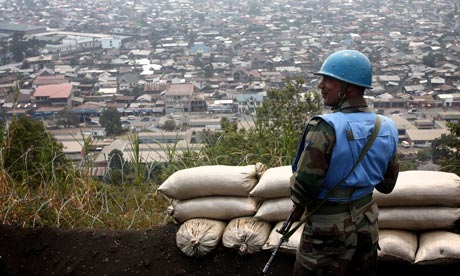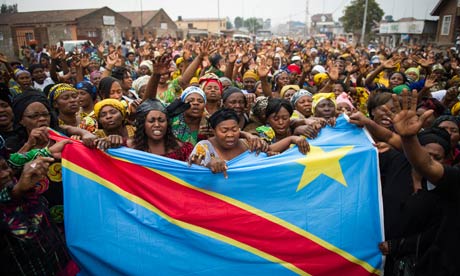 After 14 years, with a budget of $1.5bn a year, and employing 20,000 uniformed staff, the UN peacekeeping force in the Democratic Republic of the Congo
is the largest mission in the organisation's history. Yet the force,
currently known as Monusco, is struggling for credibility. On Twitter,
critics have given it the hashtag #MONUSELESS.
After 14 years, with a budget of $1.5bn a year, and employing 20,000 uniformed staff, the UN peacekeeping force in the Democratic Republic of the Congo
is the largest mission in the organisation's history. Yet the force,
currently known as Monusco, is struggling for credibility. On Twitter,
critics have given it the hashtag #MONUSELESS.Peacekeepers have been blamed for standing by when rebels from the allegedly Rwanda-backed March 23 movement (M23) conquered the city of Goma for 10 days last November. It has also been accused of blurring the lines between military and humanitarian activity, and for having an appalling record in protecting the civilian population – one of its two major aims. The second is to help restoring state authority, which requires engaging with politicians and public servants with sometimes dubious motives and propping up an army notorious for human rights abuses.
Monusco and its predecessor, Monuc, never had an easy task. Started in 1999 as an observer mission, a relatively small team found itself watching the gloomy reality of a conflict known as Africa's "world war", pitting nine countries and even more rebel groups against each other. The UN security council enlarged the mission, expanded its mandate and tasked it with ensuring the success of Congo's first democratic elections in 2006. But Monuc often remained toothless, depending on additional backup: during elections an EU force was called on to secure Kinshasa. Monuc was not able to prevent the siege of Bukavu by rebel commanders in 2004 or to counter threats posed by the Rwandan FDLR militia or Laurent Nkunda's National Congress for the Defence of the Congolese People (CNDP) rebellion.
Ironically labelled a post-conflict country since the 2006 election, the DRC continued to suffer from ill-conceived international intervention, insecurity, and ongoing rebel attacks in the east. In 2010 this culminated in Monuc's transition to Monusco, following growing international criticism and threats of expulsion from the president, Joseph Kabila. During the country's second elections in 2011, Monusco witnessed a rise in armed group activity in eastern Congo and the subsequent creation of M23.

Congolese women call for peace in Goma. Photograph: AFP/AFP/Getty Images
After the fall of Goma, the acronyms flourished. The UN security council posed the creation of a Neutral International Force (NIF), set up by the regional International Conference of the Great Lakes Region (ICGLR). In its most recent DRC resolution, the UN established a Force Intervention Brigade (FIB) which was given a mandate to "neutralise" armed groups. Meanwhile, the Peace, Security, and Cooperation Framework (PSCF), the first promising international agreement in years, was signed and UN secretary general, Ban Ki-Moon, appointed the former Irish president, Mary Robinson, as special envoy to the area.
Against all odds, Monusco has had some successes. While protection failures made the news (for example reports of the women who threw their children over the fence of a Monusco base before being slaughtered by approaching militiamen), experts agree that without the UN mission insecurity would be worse in DRC.
Although it has only recently become fully operational, the Force Intervention Brigade already faces mockery. From delayed deployment to a confusing ultimatum establishing a security zone around Goma, it manoeuvred from one blunder into another. Public relations were never among the peacekeeping mission's strengths, but the chaos exposed a serious problem with leadership. Recently, German diplomat Martin Kobler replaced Roger Meece as head of mission only after a one month. Of two deputies who assumed interim command, it was humanitarian coordinator, Moustapha Soumaré, who announced the military ultimatum. After a lively debate over the dangers of blurring peacekeeping and humanitarian action, there were questions about why a humanitarian chief was announcing military operations.
Similar on the military side: Monusco's new force commander Lt-Gen Carlos dos Santos Cruz, and Brig-Gen James Mwakibolwa, the Tanzanian head of the FIB, joined the mission only in June. Some countries contributing troops seemed to be focused on monetary rewards, backing off as risks surface.
To make matters worse, Monusco has a hard time dealing with the state. The security council introduced the mission into an environment reluctant to reform. of full-scale reform deadlock. It will be crucial for Kobler to put pressure on the DRC government and assure the credibility of upcoming talks between the state, opposition parties and civil society. Notwithstanding the diplomatic constraints, there is little alternative to a serious push for security sector reform and disarmament, demobilisation, and reintegration. Current efforts, such as digitalising the army registers for proper pay and a new, comprehensive disarmament programme (as indicated by rumours from New York and Kinshasa) only work if accompanied by strong political clout. Once soldiers are paid and disarmament efforts include real reintegration of demobilised combatants, Congo's cycle of militarisation may be easier to tackle.
With more than 40 armed rebel groups operating in eastern DRC, most of them small and locally confined, the M23 and FDLR are just the tip of an iceberg. Alas, the UN's present carrots-and-sticks approach is defunct as there are neither carrots nor sticks: the former are either unethical (eg amnesty for war criminals) or unrealistic (eg successful peace talks in the near future). On the side of sticks, the intervention brigade is yet to deliver proof that it can live up to expectations without acting too partially in its support to the government army.
In late August, renewed frays engaged M23 and the army after a three weeks lull. Both sides accuse each other of causing havoc in a propaganda war as vivid as battlefield developments. As bombs fell both in Congo and neighbouring Rwanda, the two countries blamed each other for violating territorial sovereignty. The UN attributes the shelling to M23 and ordered the intervention brigade's first participation in the hostilities on 23 August, firing on M23 positions north of Goma. Triggered by increasing war fatigue, massive anti-Monusco demonstrations followed. Many civilians blame Monusco for not protecting Goma, but protests were also aimed at M23 and the government. Since 28 August, M23 and FARDC have been embroiled in heavy clashes again, dragging in the intervention brigade and possibly the Rwandan army, which announced a reaction if shelling onto Gisenyi continue. The brigade suffered its first casualty.
With M23 declaring a unilateral ceasefire on Friday, there are indications - however fragile - that the joint UN and DRC mission might be gaining the upper hand. If Monusco hopes to succeed, it should transform past weaknesses by using its political clout from above while joining forces with Congolese civil society below. For the new head Martin Kobler, UN special envoy Mary Robinson, and others, perhaps there is even a window of opportunity.
Christoph Vogel is a Mercator Fellow on International Affairs and a PhD researcher on the Democratic Republic of the Congo. He writes at www.christophvogel.net and tweets as @ethuin
After the fall of Goma, the acronyms flourished. The UN security council posed the creation of a Neutral International Force (NIF), set up by the regional International Conference of the Great Lakes Region (ICGLR). In its most recent DRC resolution, the UN established a Force Intervention Brigade (FIB) which was given a mandate to "neutralise" armed groups. Meanwhile, the Peace, Security, and Cooperation Framework (PSCF), the first promising international agreement in years, was signed and UN secretary general, Ban Ki-Moon, appointed the former Irish president, Mary Robinson, as special envoy to the area.
Against all odds, Monusco has had some successes. While protection failures made the news (for example reports of the women who threw their children over the fence of a Monusco base before being slaughtered by approaching militiamen), experts agree that without the UN mission insecurity would be worse in DRC.
Although it has only recently become fully operational, the Force Intervention Brigade already faces mockery. From delayed deployment to a confusing ultimatum establishing a security zone around Goma, it manoeuvred from one blunder into another. Public relations were never among the peacekeeping mission's strengths, but the chaos exposed a serious problem with leadership. Recently, German diplomat Martin Kobler replaced Roger Meece as head of mission only after a one month. Of two deputies who assumed interim command, it was humanitarian coordinator, Moustapha Soumaré, who announced the military ultimatum. After a lively debate over the dangers of blurring peacekeeping and humanitarian action, there were questions about why a humanitarian chief was announcing military operations.
Similar on the military side: Monusco's new force commander Lt-Gen Carlos dos Santos Cruz, and Brig-Gen James Mwakibolwa, the Tanzanian head of the FIB, joined the mission only in June. Some countries contributing troops seemed to be focused on monetary rewards, backing off as risks surface.
To make matters worse, Monusco has a hard time dealing with the state. The security council introduced the mission into an environment reluctant to reform. of full-scale reform deadlock. It will be crucial for Kobler to put pressure on the DRC government and assure the credibility of upcoming talks between the state, opposition parties and civil society. Notwithstanding the diplomatic constraints, there is little alternative to a serious push for security sector reform and disarmament, demobilisation, and reintegration. Current efforts, such as digitalising the army registers for proper pay and a new, comprehensive disarmament programme (as indicated by rumours from New York and Kinshasa) only work if accompanied by strong political clout. Once soldiers are paid and disarmament efforts include real reintegration of demobilised combatants, Congo's cycle of militarisation may be easier to tackle.
With more than 40 armed rebel groups operating in eastern DRC, most of them small and locally confined, the M23 and FDLR are just the tip of an iceberg. Alas, the UN's present carrots-and-sticks approach is defunct as there are neither carrots nor sticks: the former are either unethical (eg amnesty for war criminals) or unrealistic (eg successful peace talks in the near future). On the side of sticks, the intervention brigade is yet to deliver proof that it can live up to expectations without acting too partially in its support to the government army.
In late August, renewed frays engaged M23 and the army after a three weeks lull. Both sides accuse each other of causing havoc in a propaganda war as vivid as battlefield developments. As bombs fell both in Congo and neighbouring Rwanda, the two countries blamed each other for violating territorial sovereignty. The UN attributes the shelling to M23 and ordered the intervention brigade's first participation in the hostilities on 23 August, firing on M23 positions north of Goma. Triggered by increasing war fatigue, massive anti-Monusco demonstrations followed. Many civilians blame Monusco for not protecting Goma, but protests were also aimed at M23 and the government. Since 28 August, M23 and FARDC have been embroiled in heavy clashes again, dragging in the intervention brigade and possibly the Rwandan army, which announced a reaction if shelling onto Gisenyi continue. The brigade suffered its first casualty.
With M23 declaring a unilateral ceasefire on Friday, there are indications - however fragile - that the joint UN and DRC mission might be gaining the upper hand. If Monusco hopes to succeed, it should transform past weaknesses by using its political clout from above while joining forces with Congolese civil society below. For the new head Martin Kobler, UN special envoy Mary Robinson, and others, perhaps there is even a window of opportunity.
Christoph Vogel is a Mercator Fellow on International Affairs and a PhD researcher on the Democratic Republic of the Congo. He writes at www.christophvogel.net and tweets as @ethuin
No comments:
Post a Comment